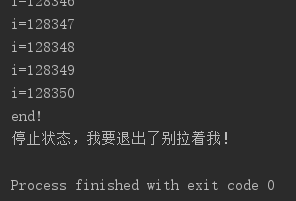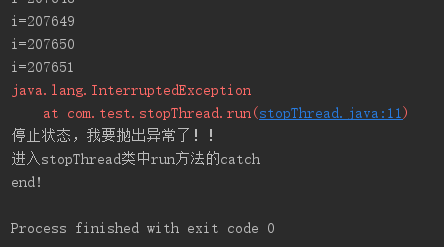Java多线程之停止线程
2018-01-04 00:00
357 查看
前言:Java提供了3种终止正在运行的线程的方法
a、使用推出标志,使线程正常退出,也就是在run方法完成后线程自然终止
b、使用interrupt方法中断线程
c、使用stop方法强行终止线程,不推荐(过期作废)
以下主要介绍第二种方法,使用interrupt方法。
大多数停止一个线程都会使用 Thread.unterrupt() 方法,但是很这个方法不会终止正在运行的线程,需要加入一个判断才可以完成线程的停止。
示例1:
MyThread.java
Run.java
运行Run后会发现,输出还是有500000行,说明interrupt方法并没有让线程终止。
怎么判断线程是否是停止状态?
Thread.java提供了了两种方法判断线程是不是停止的。
a、判断当前线程是否已经中断 this.interrupted(); (public static boolean interrupted() )
b、判断线程是否已经中断 this.isInterrupted(); ( public boolean sInterrupted() )
示例a-1:线程实例产生中断效果
Run1.java
输出结果中,两次 thread.interrupted() 都为 false
原因是,当前线程指的是main,500000次输出还没执行完毕,即使调用了 thread.interrupted(),线程还是没终止,所以返回值都是false。
示例a-2: 让main线程产生中断效果
Run2.java
输出结果中,第一个 Thread.interrupted() 为 true,第二个 Thread.interrupted() 为 false
原因是,interrupted 方法具有清除状态的功能,即连续调用两次第二次会返回false。
示例b-1:使用isInterrupted方法
在500000行输出中间打印出 两个 true 和 end
方法isInterrupted没有清除状态,所以两个都是true
总结:
1)this.interrupted() : 测试当前线程是否已经是中断状态,执行后将状态标志清除,置为false。
2)this.isinterrupted() : 测试线程Thread对象是否已经是中断状态,但不清除状态标志。
示例一:在线程for循环中加入判断,判断是否为停止状态,若是,则break让for循环不再执行
stopThread.java
RunStop.java
输出结果为:

这种方式退出线程只是跳出循环,for循环后面的代码还是会继续循环。
示例二:异常法
stopThread.java
runStop.java
输出结果:

--------------未完,待续。
a、使用推出标志,使线程正常退出,也就是在run方法完成后线程自然终止
b、使用interrupt方法中断线程
c、使用stop方法强行终止线程,不推荐(过期作废)
以下主要介绍第二种方法,使用interrupt方法。
大多数停止一个线程都会使用 Thread.unterrupt() 方法,但是很这个方法不会终止正在运行的线程,需要加入一个判断才可以完成线程的停止。
示例1:
MyThread.java
public class MyThread extends Thread{
@Override
public void run(){
super.run();
for (int i=0;i<500000;i++){
System.out.println("i=" + (i+1));
}
}
}Run.java
public class Run {
public static void main(String[] args) {
try {
MyThread thread = new MyThread();
thread.start();
thread.sleep(2000);
thread.interrupt();
}catch (InterruptedException e){
System.out.println("main catch");
e.printStackTrace();
}
}
}运行Run后会发现,输出还是有500000行,说明interrupt方法并没有让线程终止。
怎么判断线程是否是停止状态?
Thread.java提供了了两种方法判断线程是不是停止的。
a、判断当前线程是否已经中断 this.interrupted(); (public static boolean interrupted() )
b、判断线程是否已经中断 this.isInterrupted(); ( public boolean sInterrupted() )
示例a-1:线程实例产生中断效果
Run1.java
public class Run1 {
public static void main(String[] args) {
try {
MyThread thread = new MyThread();
thread.start();
thread.sleep(1000);
thread.interrupt();
System.out.println("1是否停止? = " + thread.interrupted());
System.out.println("2是否停止? = " + thread.interrupted());
}catch (InterruptedException e){
System.out.println("main catch");
e.printStackTrace();
}
System.out.println("end");
}
}输出结果中,两次 thread.interrupted() 都为 false
原因是,当前线程指的是main,500000次输出还没执行完毕,即使调用了 thread.interrupted(),线程还是没终止,所以返回值都是false。
示例a-2: 让main线程产生中断效果
Run2.java
public class Run2 {
public static void main(String[] args) {
Thread.currentThread().interrupt();
System.out.println("1是否停止? = " + Thread.interrupted());
System.out.println("2是否停止? = " + Thread.interrupted());
System.out.println("end");
}
}输出结果中,第一个 Thread.interrupted() 为 true,第二个 Thread.interrupted() 为 false
原因是,interrupted 方法具有清除状态的功能,即连续调用两次第二次会返回false。
示例b-1:使用isInterrupted方法
public class Run3 {
public static void main(String[] args) {
try {
MyThread thread = new MyThread();
thread.start();
thread.sleep(1000);
thread.interrupt();
System.out.println("1是否停止? = " + thread.isInterrupted());
System.out.println("2是否停止? = " + thread.isInterrupted());
}catch (InterruptedException e){
System.out.println("main catch");
e.printStackTrace();
}
System.out.println("end");
}
}在500000行输出中间打印出 两个 true 和 end
方法isInterrupted没有清除状态,所以两个都是true
总结:
1)this.interrupted() : 测试当前线程是否已经是中断状态,执行后将状态标志清除,置为false。
2)this.isinterrupted() : 测试线程Thread对象是否已经是中断状态,但不清除状态标志。
示例一:在线程for循环中加入判断,判断是否为停止状态,若是,则break让for循环不再执行
stopThread.java
public class stopThread extends Thread {
@Override
public void run(){
super.run();
for (int i=0;i<500000;i++){
if (this.isInterrupted()) {
System.out.println("停止状态,我要退出了别拉着我!");
break;
}
System.out.println("i=" + (i+1));
}
}
}RunStop.java
public class RunStop {
public static void main(String[] args) {
try{
stopThread sThread = new stopThread();
sThread.start();
Thread.sleep(2000);
sThread.interrupt();
}catch (InterruptedException e) {
System.out.println("main catch");
e.printStackTrace();
}
System.out.println("end!");
}
}输出结果为:

这种方式退出线程只是跳出循环,for循环后面的代码还是会继续循环。
示例二:异常法
stopThread.java
public class stopThread extends Thread {
@Override
public void run(){
super.run();
try {
for (int i=0;i<500000;i++){
if (this.isInterrupted()) {
System.out.println("停止状态,我要抛出异常了!!");
throw new InterruptedException();
}
System.out.println("i=" + (i+1));
}
}catch (InterruptedException e) {
System.out.println("进入stopThread类中run方法的catch");
e.printStackTrace();
}
}
}runStop.java
public class RunStop {
public static void main(String[] args) {
try{
stopThread sThread = new stopThread();
sThread.start();
Thread.sleep(2000);
sThread.interrupt();
}catch (InterruptedException e) {
System.out.println("main catch");
e.printStackTrace();
}
System.out.println("end!");
}
}输出结果:

--------------未完,待续。
相关文章推荐
- 27、Java入门—多线程之线程的正确停止
- java多线程之-----停止线程
- Java中的多线程(四)之线程的停止
- java 多线程 停止线程几种方式
- Java多线程之停止线程
- Java 多线程 学习笔记 线程的停止
- java高级多线程编程--关于线程的停止问题
- java高级多线程编程--关于线程的停止问题
- java 多线程(1) join() / interrupt() 打断sleep() / stop() / run() / 线程停止的方法
- java高级多线程编程--关于线程的停止问题
- java高级多线程编程--关于线程的停止问题
- 【Java 语言】Java 多线程 一 ( 线程基础 : 线程启动 | 线程停止 | 线程暂停 | 线程优先级 | 守护线程)
- Java 多线程学习(2)——停止线程
- 【Java 多线程】Java 如何停止线程
- java高级多线程编程--关于线程的停止问题
- Java多线程(五)停止线程 interrupt
- JAVA之旅(十五)——多线程的生产者和消费者,停止线程,守护线程,线程的优先级,setPriority设置优先级,yield临时停止
- java高级多线程编程--关于线程的停止问题
- Java进阶学习2-多线程之停止线程
- JAVA之旅(十五)——多线程的生产者和消费者,停止线程,守护线程,线程的优先级,setPriority设置优先级,yield临时停止
